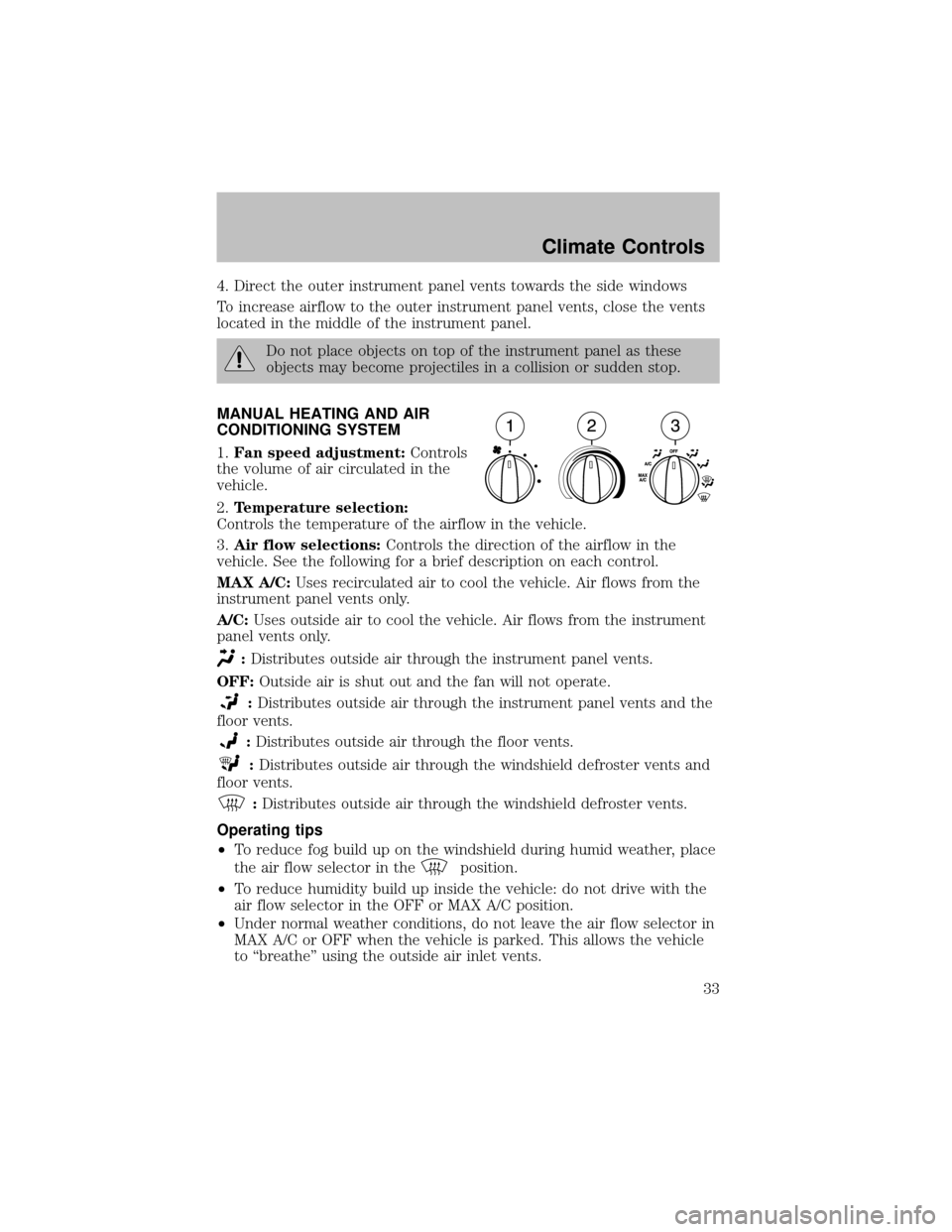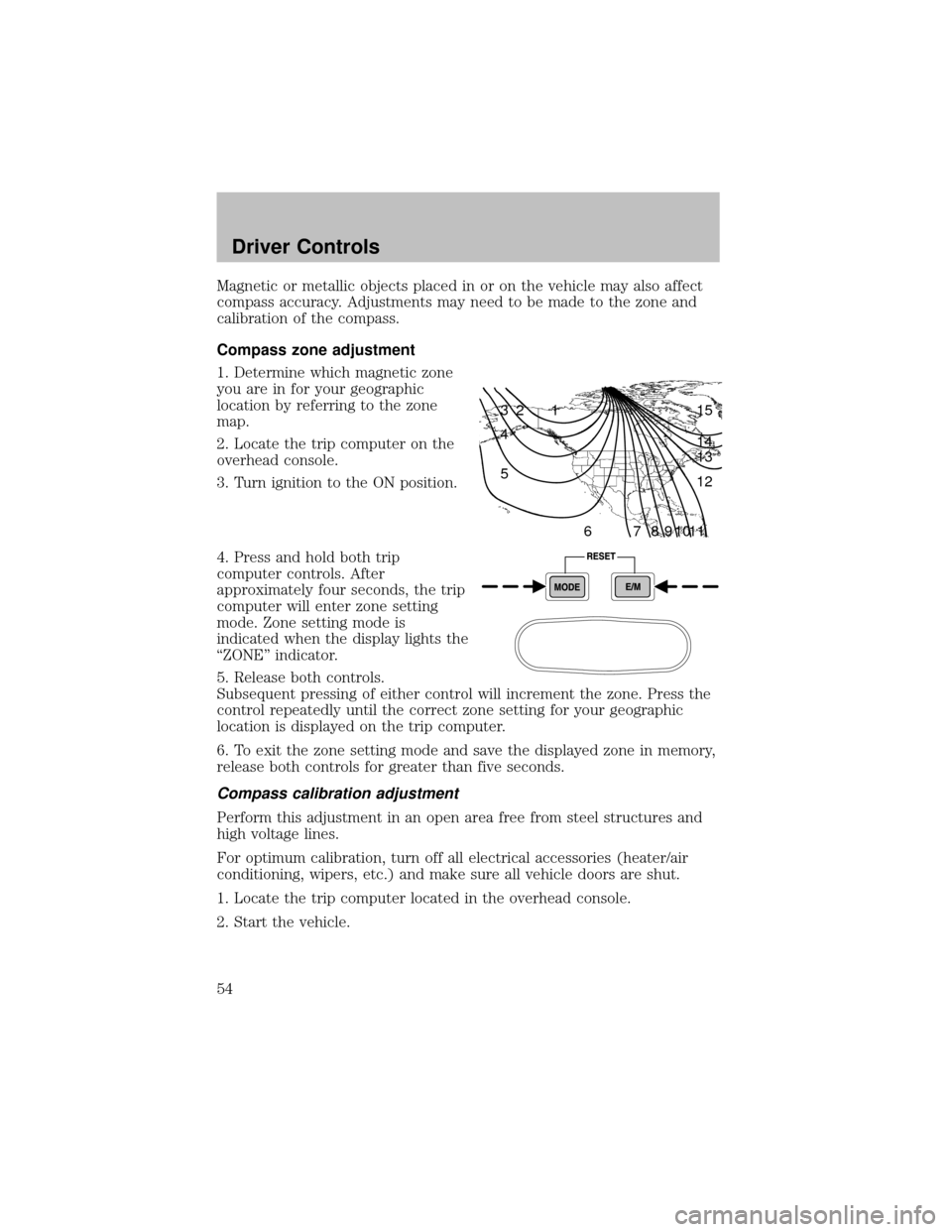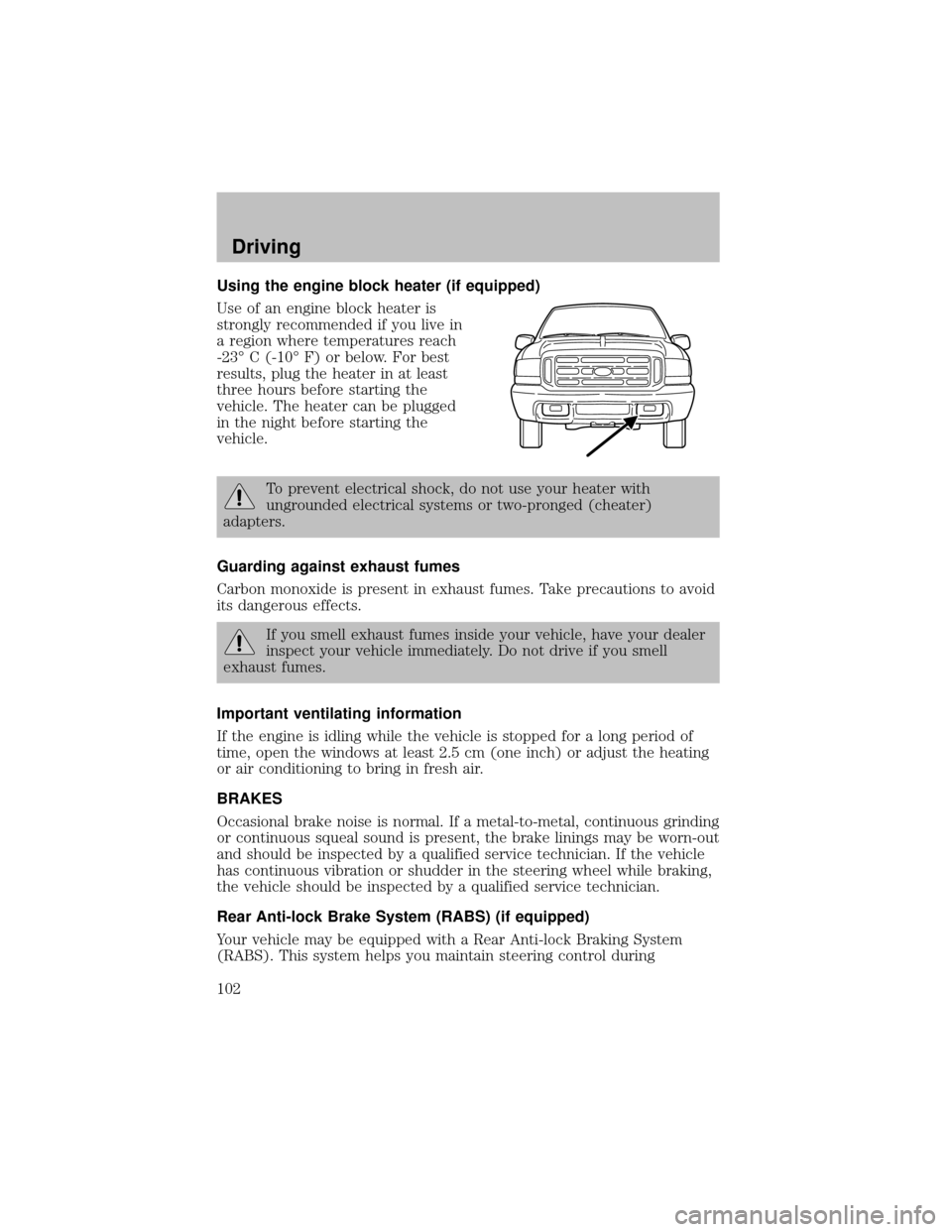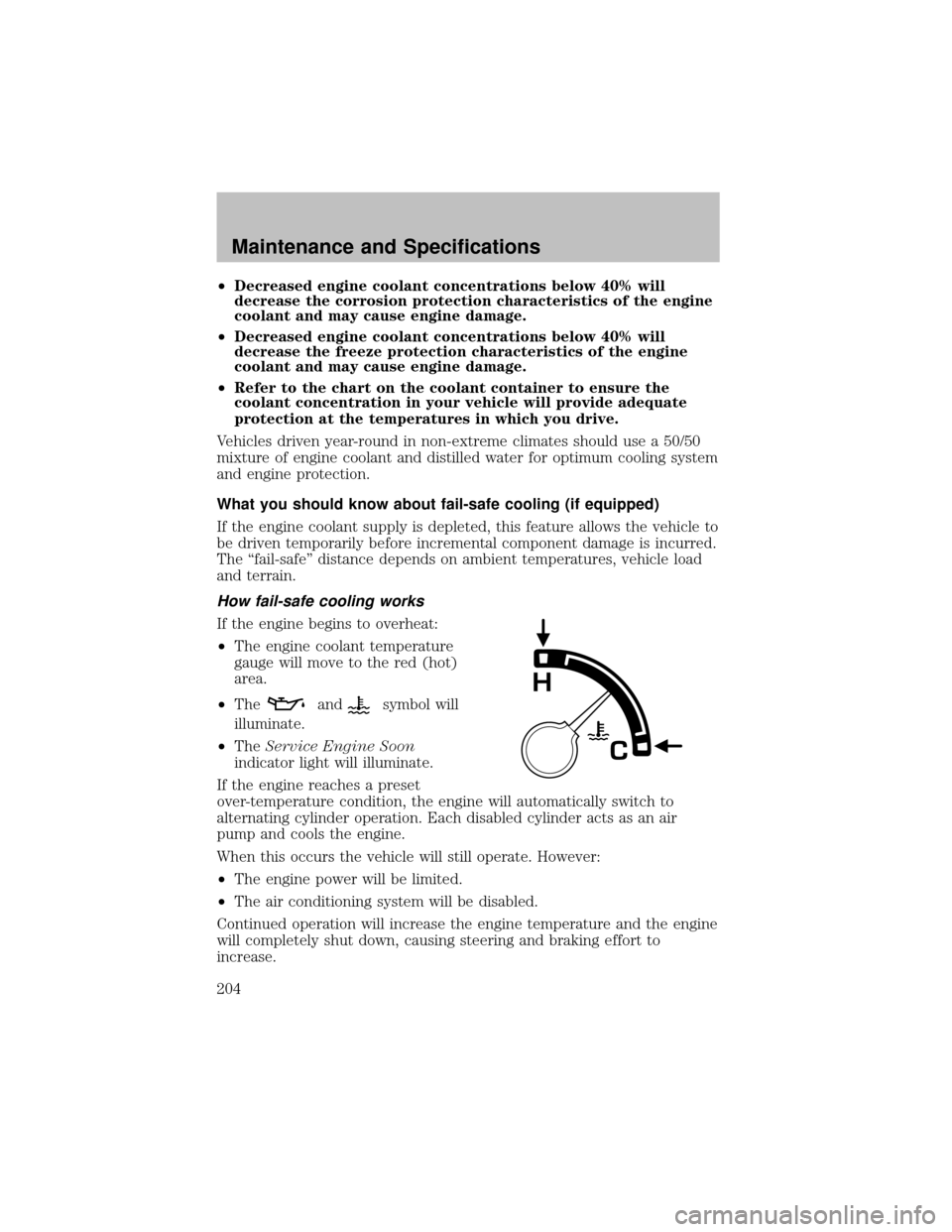2003 FORD SUPER DUTY air conditioning
[x] Cancel search: air conditioningPage 1 of 256

Introduction 4
Instrument Cluster 10
Warning and control lights 10
Gauges 13
Entertainment Systems 17
AM/FM stereo 17
AM/FM stereo cassette 18
AM/FM stereo cassette with CD 21
AM/FM stereo with CD 25
CD changer 28
Climate Controls 32
Heater only32
Manual heating and air conditioning 33
Lights 35
Headlamps 35
Turn signal control 37
Bulb replacement 38
Driver Controls 44
Windshield wiper/washer control 44
Power windows 47
Mirrors 47
Speed control 48
Message center 51
Locks and Security 56
Keys 56
Locks 56
Anti-theft system 58
Table of Contents
1
Page 33 of 256

4. Direct the outer instrument panel vents towards the side windows
To increase airflow to the outer instrument panel vents, close the vents
located in the middle of the instrument panel.
Do not place objects on top of the instrument panel as these
objects maybecome projectiles in a collision or sudden stop.
MANUAL HEATING AND AIR
CONDITIONING SYSTEM
1.Fan speed adjustment:Controls
the volume of air circulated in the
vehicle.
2.Temperature selection:
Controls the temperature of the airflow in the vehicle.
3.Air flow selections:Controls the direction of the airflow in the
vehicle. See the following for a brief description on each control.
MAX A/C:Uses recirculated air to cool the vehicle. Air flows from the
instrument panel vents only.
A/C:Uses outside air to cool the vehicle. Air flows from the instrument
panel vents only.
:Distributes outside air through the instrument panel vents.
OFF:Outside air is shut out and the fan will not operate.
:Distributes outside air through the instrument panel vents and the
floor vents.
:Distributes outside air through the floor vents.
:Distributes outside air through the windshield defroster vents and
floor vents.
:Distributes outside air through the windshield defroster vents.
Operating tips
•To reduce fog build up on the windshield during humid weather, place
the air flow selector in the
position.
•To reduce humiditybuild up inside the vehicle: do not drive with the
air flow selector in the OFF or MAX A/C position.
•Under normal weather conditions, do not leave the air flow selector in
MAX A/C or OFF when the vehicle is parked. This allows the vehicle
to “breathe” using the outside air inlet vents.
Climate Controls
33
Page 54 of 256

Magnetic or metallic objects placed in or on the vehicle mayalso affect
compass accuracy. Adjustments may need to be made to the zone and
calibration of the compass.
Compass zone adjustment
1. Determine which magnetic zone
you are in for your geographic
location byreferring to the zone
map.
2. Locate the trip computer on the
overhead console.
3. Turn ignition to the ON position.
4. Press and hold both trip
computer controls. After
approximatelyfour seconds, the trip
computer will enter zone setting
mode. Zone setting mode is
indicated when the displaylights the
“ZONE” indicator.
5. Release both controls.
Subsequent pressing of either control will increment the zone. Press the
control repeatedlyuntil the correct zone setting for your geographic
location is displayed on the trip computer.
6. To exit the zone setting mode and save the displayed zone in memory,
release both controls for greater than five seconds.
Compass calibration adjustment
Perform this adjustment in an open area free from steel structures and
high voltage lines.
For optimum calibration, turn off all electrical accessories (heater/air
conditioning, wipers, etc.) and make sure all vehicle doors are shut.
1. Locate the trip computer located in the overhead console.
2. Start the vehicle.
1 2 3
4
5
6 7 8 9 101112 13 14 15
Driver Controls
54
Page 102 of 256

Using the engine block heater (if equipped)
Use of an engine block heater is
stronglyrecommended if you live in
a region where temperatures reach
-23° C (-10° F) or below. For best
results, plug the heater in at least
three hours before starting the
vehicle. The heater can be plugged
in the night before starting the
vehicle.
To prevent electrical shock, do not use your heater with
ungrounded electrical systems or two-pronged (cheater)
adapters.
Guarding against exhaust fumes
Carbon monoxide is present in exhaust fumes. Take precautions to avoid
its dangerous effects.
If you smell exhaust fumes inside your vehicle, have your dealer
inspect your vehicle immediately. Do not drive if you smell
exhaust fumes.
Important ventilating information
If the engine is idling while the vehicle is stopped for a long period of
time, open the windows at least 2.5 cm (one inch) or adjust the heating
or air conditioning to bring in fresh air.
BRAKES
Occasional brake noise is normal. If a metal-to-metal, continuous grinding
or continuous squeal sound is present, the brake linings maybe worn-out
and should be inspected bya qualified service technician. If the vehicle
has continuous vibration or shudder in the steering wheel while braking,
the vehicle should be inspected bya qualified service technician.
Rear Anti-lock Brake System (RABS) (if equipped)
Your vehicle maybe equipped with a Rear Anti-lock Braking System
(RABS). This system helps you maintain steering control during
Driving
102
Page 204 of 256

•Decreased engine coolant concentrations below 40% will
decrease the corrosion protection characteristics of the engine
coolant and may cause engine damage.
•Decreased engine coolant concentrations below 40% will
decrease the freeze protection characteristics of the engine
coolant and may cause engine damage.
•Refer to the chart on the coolant container to ensure the
coolant concentration in your vehicle will provide adequate
protection at the temperatures in which you drive.
Vehicles driven year-round in non-extreme climates should use a 50/50
mixture of engine coolant and distilled water for optimum cooling system
and engine protection.
What you should know about fail-safe cooling (if equipped)
If the engine coolant supplyis depleted, this feature allows the vehicle to
be driven temporarilybefore incremental component damage is incurred.
The “fail-safe” distance depends on ambient temperatures, vehicle load
and terrain.
How fail-safe cooling works
If the engine begins to overheat:
•The engine coolant temperature
gauge will move to the red (hot)
area.
•The
andsymbol will
illuminate.
•TheService Engine Soon
indicator light will illuminate.
If the engine reaches a preset
over-temperature condition, the engine will automaticallyswitch to
alternating cylinder operation. Each disabled cylinder acts as an air
pump and cools the engine.
When this occurs the vehicle will still operate. However:
•The engine power will be limited.
•The air conditioning system will be disabled.
Continued operation will increase the engine temperature and the engine
will completelyshut down, causing steering and braking effort to
increase.
Maintenance and Specifications
204
Page 251 of 256

refill capacities ........................228
specifications ..................232, 235
Exhaust fumes ..........................102
F
Fail safe cooling ........................204
Fluid capacities .........................228
Foglamps .....................................36
Four-Wheel Drive vehicles .......113
driving off road .......................116
electronic shift ................115–116
indicator light .........................113
lever operated shift ................114
manual locking hubs ..............113
preparing to drive your
vehicle .....................................105
Fuel ............................................205
calculating fuel economy.......210
cap ...........................................207
capacity...................................228
choosing the right fuel ...........208
comparisons with EPA fuel
economyestimates .................213
detergent in fuel .....................209
filling your vehicle
with fuel ..................205, 207, 210
filter, specifications ........209, 228
fuel pump shut-off switch .....153
improving fuel economy........210
octane rating ...................208, 235
quality......................................208
running out of fuel .................209
safetyinformation relating to
automotive fuels .....................205
Fuses ..................................154–155
G
Garage door opener ....................46Gas cap (see Fuel cap) ............207
Gas mileage
(see Fuel economy) .................210
Gauges .........................................13
GAWR (Gross Axle Weight
Rating) .......................................125
calculating ...............................127
definition .................................125
driving with a heavyload ......125
location ....................................125
GVWR (Gross Vehicle Weight
Rating) .......................................125
calculating .......................125, 127
definition .................................125
driving with a heavyload ......125
location ....................................125
H
Headlamps ...................................35
aiming ........................................37
autolamp system .......................35
daytime running lights .............36
flash to pass ..............................37
high beam .................................36
replacing bulbs .........................39
turning on and off ....................35
Heating
heating and air
conditioning system ...........32–33
Hood ..........................................192
I
Ignition .................................98, 235
Infant seats (see Safetyseats) ..90
Inspection/maintenance (I/M)
testing ........................................214
Index
251